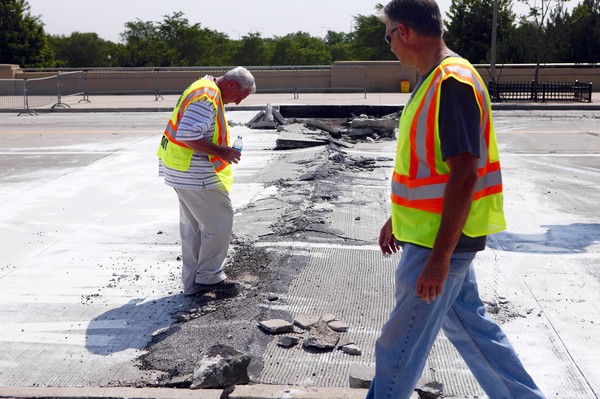
This year's high temperatures, while they made Chicago's winter considerably more bearable, have continued to wreak havoc in all sorts of expected and unexpected ways. Some are obvious, like the flash drought I wrote about recently, during which Illinois went from just slightly dry to almost completely immersed in severe drought in a matter of weeks. Others are less clear, but are at least correlative, like early warm weather and rising homicide rates.
There's also been a deleterious effect on roads: both the roads themselves, and the people who drive them. Along with homicides, traffic fatalities are up:
As of Wednesday, 533 people have been killed in vehicle and motorcycle crashes [in Illinois], as well as crashes involving bicyclists and pedestrians. That’s a 45-death increase from last year’s total through late July, when 488 deaths were recorded, figures show….
“We also have noticed that we’ve seen a 70 percent increase in motorcycle related fatalities . . . [The spike in fatalities] is part of a national trend and part of it could be that the weather was mild during the winter months and so we saw increase in travel during those months. That could be part of what’s driving the increase.”
Hence the traffic-fatality notices on CDOT electronic billboards; Eric Zorn has another idea: "if it's impact they want, I'd suggest posting the cash penalties for certain traffic violations rather than banal safety slogans." I do wonder, though, if gas prices play some role. Earlier in the year, people were expecting gas prices to hit record levels this summer; then they fell, checking inflation with them, making people just that more likely to to travel.
Roads throughout the country are suffering, along with, um, nuclear power plants:
In the Chicago area, a twin-unit nuclear plant had to get special permission to keep operating this month because the pond it uses for cooling water rose to 102 degrees; its license to operate allows it to go only to 100. According to the Midwest Independent System Operator, the grid operator for the region, a different power plant had had to shut because the body of water from which it draws its cooling water had dropped so low that the intake pipe became high and dry; another had to cut back generation because cooling water was too warm.
[snip]
In general, nobody in charge of anything made of steel and concrete can plan based on past trends, said Vicki Arroyo, who heads the Georgetown Climate Center at Georgetown University Law Center in Washington, a clearinghouse on climate-change adaptation strategies.
Columbus Drive just completely broke in the heat. In the past, the two seasons in Chicago have been winter and contstruction; perhaps in the future it will be summer and construction.
There's basically no good soil in Illinois right now:
Sixty-six percent of the Illinois corn crop was rated poor or very poor as of Sunday, according to the Illinois Department of Agriculture. Soybeans were slightly better at 49 percent poor or very poor.
Soil moisture was in sad shape, with 80 percent of the topsoil very short on moisture, 19 percent short and 1 percent adequate. Subsoils were also dry, with 77 percent very short, 20 percent short and 3 percent adequate.
And rising corn and soybean prices mean rising food prices, which threaten to eliminate the deflationary effects of declining fuel costs:
"The drought is really going to hit food prices next year," said USDA economist Richard Volpe, adding that pressure on food prices would start building later this year.
[snip]
Food prices will rise more rapidly than overall U.S. inflation, the USDA said, a turnabout from the usual pattern. U.S. inflation is estimated at 2 percent this year and 1.9 percent in 2013. Food inflation was 3.7 percent last year but only 0.8 percent in 2010.
One of the fears of climate change is that it will upset the fine, complex balances of worldwide weather patterns, leading to subtle yet important changes across oceans and continents. But a lot of very localized balances are predicated on those patterns, like how corn is grown, how power plants are cooled, and how roads are built.
Photograph: Chicago Tribune


